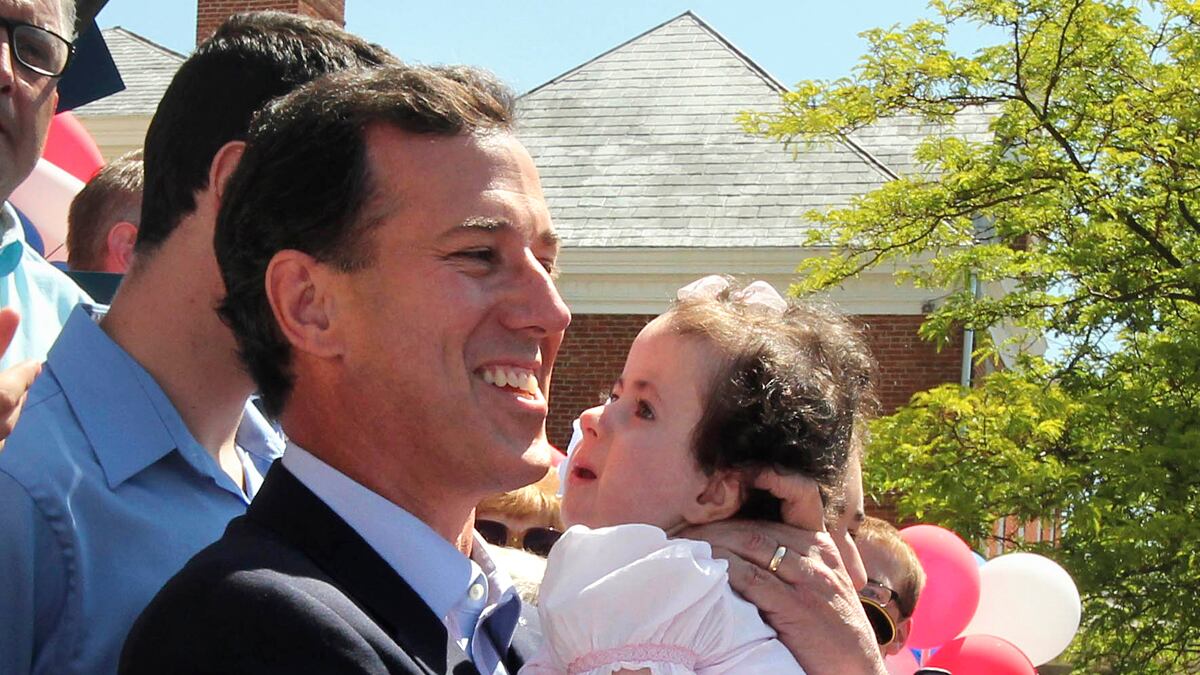Trisomy 18. I had seen the term listed in pregnancy books, but skimmed over it. I never read those sections about chromosomal abnormalities because they didn’t apply to me, and they never would. But in December 2006 I developed a familiarity with the term, and suddenly it became an intimate part of my world.
In the dimly lit, subhuman quiet of the neonatal intensive-care unit, Trisomy 18 had entered my world in the form of a newborn baby—my son. Machines monitored his heart rate, respiration, and oxygen. Protective glasses shaded his eyes from the phototherapeutic light that treated him for jaundice. Monitors beeped, voices remained hushed. This was his first brush with life on the outside. Only a few days before, he was tucked away within the safety of my womb. Outside, he wore a CPAP for oxygen.
We kissed him goodbye, hoping it would not be the last time we would see him alive. We dropped our sanitized hospital gowns in the bin and headed for the door. I took one last look at him lying helpless in his incubator, wanting to grab him and take him with me. I couldn’t. Those machines kept him breathing and warned the nurses and neonatologists of impending trouble.
He needed to remain there in order to be safe—and alive.
We learned the devastating news that our son had an extra chromosome No. 18 five days after he was born. We had been traveling across the United States after selling our house during the 2005 real-estate bubble. We quit our jobs, bought a high-deductible insurance policy, and I guaranteed Jeff I wouldn’t get pregnant because we had no maternity coverage. But on day five of our trip, in Joshua Tree National Park, I took a pregnancy test in nearby Yucca Valley. It was positive. We managed to find prenantal care along the way. None of the doctors we saw ever detected any problems with the baby. Even the quad screen test came back normal.

“He has Trisomy 18. He will die,” the neonatologist told us outside the NICU.
I instantly fell apart. My world fractured into tiny pieces. I crumpled into my husband’s arms, shocked by the bluntness of the statement. Instead of celebrating my son’s life, I was faced with the loss of it head on.
The doctor flipped through the paperwork he had carried in. Pictures of magnified chromosomes; on Zane’s FISH (fluorescent in situ hybridization) test, there are three of the 18th chromosome instead of the typical two. Other papers made their way toward us. As the doctor walked us through them, there was no sliver of hope, no loopholes allowing for Zane’s well-being. Phrases jumped out at me, none of which were good: congenital heart defects, feeding difficulties, severe to profound mental retardation. And, above all, death.
In the NICU we held Zane for hours, knowing that it might be the last time we saw and held him.
With Zane’s Trisomy 18 diagnosis, his corner of the NICU shut down. There was no more bustle around his crib; the heart monitor had been pulled; the oxygen-saturation machine was silenced. There was no longer immediacy to caring for Zane by anyone other than us. They waited for him to die while we clung to all the living moments we had with him.
When we are able to pause for a time, Jeff and I read about Trisomy 18. Aside from the severe to profound mental retardation that the neonatologist “warned” us about, there are a potential 130 anomalies associated with the condition. Some were already apparent with Zane: clenched fists, elfin-like ears, small body weight, a weak cry, feeding difficulties. Those are less concerning than the potentially unseen problems: congenital heart issues, kidney defects, and seizures. Most prominent in all of the literature: Trisomy 18 is often fatal. Less than 10 percent make it to their first birthdays.

We rode some minor ups and downs. The medical community dissected Zane, functioning system by functioning system, body part by body part. We learned to place the information we were given into their various compartments: cardiovascular, renal, orthopedic, neurological, and so on.
Despite our signatures on a DNR (do not resuscitate) form, we learned that the NICU staff accidentally revived Zane during a significant drop in his oxygen saturation. Because—or in spite—of that, things seemed to progress quite well for our son.
Jeff and I ran into the neonatologist in the NICU lobby. He took extra time with us because our situation was so hopeless. He asked how we were doing, then incidentally told us that a number of Zane’s tests had come back. There was no evidence of heart or renal problems.
“It looks like you’ll be taking him home.”
What did that mean? We had been told to prepare for Zane’s inevitable death in the NICU. Now we were supposed to take him home?
“He may live for two months or so. The central apnea will eventually take him.”
Central apnea happens when the breathing suddenly stops. In Zane’s case, due to neurological damage, his brain would forget to tell him to breathe.
With this new piece of information, we panicked. It was not that we didn’t want to take Zane with us, but we relied so heavily on the nursing staff to care for him. We expected him to die. How were we supposed to care for him on our own? And furthermore, what if he died while in our care? Taking him home brought on a whole new set of stresses. Yet we learned how to do it.
We signed him up for hospice care, knowing that we still had limited time with him.
Zane was discharged after 17 days in the NICU. When we arrived back at the house, Justin, our healthy 2-year-old, and Zane met in person for the first time. Glass no longer separated the two brothers. When Justin saw Zane, he seemed excited. He kissed his little brother, and we took lots of photos. Justin did not realize the gravity of the moment, how weighted it was with my feelings of loss, how big a deal it was to have his little brother there. To most people it was just another day in the life of a newborn. To us, it was like winning the lottery.
Zane left the hospital under hospice care; he didn’t have long to live.
The nurse came daily to check his vitals, answer questions, and provide guidance and reassurance to Jeff and me. Since Zane required care every three hours (gavage feeding through a tube, with the extensive checks that accompanied it) and the care itself took more than an hour to do, with the slow-gravity feed through a 60 ml syringe, Justin received very little of our time.
Zane experienced ups and downs: infections, blocked tear ducts, and a bilateral inguinal hernia that would eventually have to be repaired if he lived. More troubling were the episodes of central apnea we had been warned about. There were many times when Jeff and I would find Zane blue, not breathing. We’d jostle him back to awareness, back to life. We often fell asleep at night with Zane in an infant travel bed next to me, wondering if he would be dead by morning. He went through a period of seizures, respiratory illnesses, and a time when he almost died when his oxygen-saturation level plummeted to 26. Despite the many brushes with death, Zane continued to live. He is past his fifth birthday, and I still wonder if this one will be his last.
Zane is very cognitively impaired and very physically impaired—he can’t stand or walk, and he can’t sit without support. But the great thing about him is, he’s such a happy kid. He is interactive, he loves people, he’s very engaging. He is in preschool four half-days a week. In our rural area of southwestern Colorado, the school district has a Board of Cooperative Educational Services (BOCES) that provides special-education services, so Zane goes to school with a paraprofessional, who is his one-on-one aide. And he has a speech therapist, a physical therapist, and an occupational therapist who help him meet his goals. San Juan BOCES is specifically about educational needs in a school setting. That is paid for by federal and state money around special education—the funding that is the same as you’d get for a child with dyslexia or autism. Because he is permanently disabled, he will always get care from Medicaid. We have a great pediatrician in town, and people are learning a lot more about Trisomy 18, especially with the increased awareness since Rick Santorum left the presidential-campaign trail to be with his daughter, Bella, who is affected with Trisomy 18, at her hospital bedside as she bravely fought pneumonia.
My husband and I look at Santorum’s decision to cancel some of his engagements, and we think, yes, he’s a father first. I don’t know that anyone would look at that as a wrong decision. Pneumonia could be the final straw for a Trisomy 18 baby, so he made the right decision to go home and visit his critically ill child in the hospital. We connect with about 20 families with Trisomy 18 through social media, and I would think that they all feel Santorum made the right decision. Politician or not, family comes first.
In the eyes of many medical professionals, a child with Trisomy 18 is doomed. Why bother to administer extra care? Perform heart surgery? Give the parents a reason to hope? Certainly, we experienced this attitude from medical professionals. A neurologist who saw Zane at 4 months for seizures said that his feeding issues were nature’s way of controlling the population. While this may be true, it is not something a parent wants or needs to hear when grappling with the fragile life of a child. When Zane had a gastrostomy tube placed at 7 months of age, a gastroenterologist at the children’s hospital told me how “psycho” it was that Zane was sent home under hospice care with a feeding tube. Better to starve him, was her argument.
There are many great doctors who have cared for Zane. There are many not-so-good ones as well. While Trisomy 18 is usually fatal, it is not always. And even with the shortened life expectancy of children living with the diagnosis, there should be a level of compassion on the part of the medical world when handling families such as ours.
We appreciated the neonatologist’s honesty about the statistics associated with Trisomy 18. But Zane is a living example of how the medical community is not the end-all of knowledge. They do not have crystal balls or prophetic gifts. As such, many of them should not pretend that they do. We had little or no hope for our son. With the doom and gloom presented to us, we lived in a place riddled with anxiety and hopelessness.
This is not how it should be with an extra 18th chromosome. Everyone, regardless of genetic makeup, ability, or disability, should be treated with kindness and compassion, especially when their lives are so limited.






